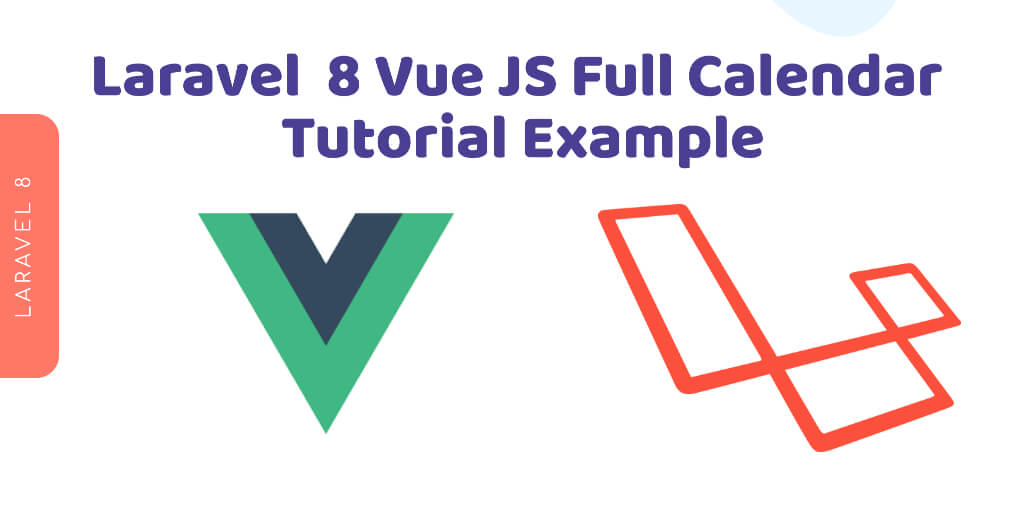Laravel 8 Vue js fullcalendar tutorial. In this tutorial, you will learn how to display events on the calendar using vue js fullcalendar components in laravel 8 apps.
FullCalendar is a lightweight yet powerful and developer-friendly JavaScript library to create flexible, draggable event calendars on the modern web app. Note that the FullCalendar now works as a Vanilla (ES6) JavaScript since v4, which removes jQuery and moment as dependencies
This tutorial will help you how to show dynamic events on vue js full calendar using Vue full calendar components on laravel vue js apps.
Laravel 8 Vue JS FullCalendar Integration Tutorial
- Step 1: Install Laravel 8 App
- Step 2: Connecting App to Database
- Step 3: Create Model And Migration
- Step 4: NPM Module Configuration For Vue Js
- Step 5: Add Routes
- Step 6: Create Controller By Command
- Step 7: Create Vue Component
- Step 8: Create Blade Views And Initialize Vue Components
- Step 9: Run Development Server
Step 1: Install Laravel 8 App
In this step, you need to install laravel latest application setup, So open your terminal OR command prompt and run the following command:
composer create-project --prefer-dist laravel/laravel blog
Step 2: Connecting App to Database
After successfully install laravel new application, Go to your project root directory and open .env file. Then set up database credential in .env file as follow:
DB_CONNECTION=mysql DB_HOST=127.0.0.1 DB_PORT=3306 DB_DATABASE=here your database name here DB_USERNAME=here database username here DB_PASSWORD=here database password here
Step 3: Create Model And Migration
Next step, you need to run the following command:
php artisan make:model Event -m
This command will create one model name Event.php and also create one migration file for the events table.
Now open create_events_table.php migration file from database>migrations and replace up() function with following code:
<?php
use Illuminate\Support\Facades\Schema;
use Illuminate\Database\Schema\Blueprint;
use Illuminate\Database\Migrations\Migration;
class CreateEventsTable extends Migration
{
/**
* Run the migrations.
*
* @return void
*/
public function up()
{
Schema::create('events', function (Blueprint $table) {
$table->bigIncrements('id');
$table->string('title');
$table->date('start');
$table->date('end');
$table->timestamps();
});
}
/**
* Reverse the migrations.
*
* @return void
*/
public function down()
{
Schema::dropIfExists('events');
}
}
Next, migrate the table using the below command:
php artisan migrate
Next, Navigate to app/Models/Event.php and update the following code into your Event.php model as follow:
<?php
namespace App\Models;
use Illuminate\Database\Eloquent\Factories\HasFactory;
use Illuminate\Database\Eloquent\Model;
class Event extends Model
{
use HasFactory;
protected $fillable = [
];
}
Step 4: NPM Module Configuration For Vue Js
You need to setup Vue and install Vue dependencies using NPM. So run the following command on command prompt:
php artisan preset vue
Install all Vue dependencies:
npm install
After that, install vue full calendar dependencies by using the below command:
npm install --save vue-full-calendar npm install --save babel-runtime npm install babel-preset-stage-2 --save-dev npm install moment --save
Step 5: Add Routes
Next step, go to routes folder and open web.php file and add the following routes into your file:
routes/web.php
use App\Http\Controllers\EventController;
Route::get('events', [EventController::class, 'index']);
Step 6: Create Controller By Command
Next step, open your command prompt and run the following command to create a controller by an artisan:
php artisan make:controller EventController
After that, go to app\Http\Controllers and open EventController.php file. Then update the following code into your EventController.php file:
namespace App\Http\Controllers;
use App\Models\Event;
use Illuminate\Http\Request;
class EventController extends Controller
{
public function index(Request $request)
{
$events = Event::get(['title','start']);
return response()->json(["events" => $events]);
}
}
Step 7: Create Vue Component
Next step, go to resources/assets/js/components folder and create a file called FullCalendarComponent.vue.
Now, update the following code into your FullCalendarComponent.vue components file:
<template>
<div class="container">
<full-calendar :event-sources="eventSources"></full-calendar>
</div>
</template>
<script>
export default{
data() {
return {
eventSources: [
{
events(start, end, timezone, callback) {
axios.get('http://localhost:8000/events').then(response => {
callback(response.data.events)
})
},
color: 'yellow',
textColor: 'black',
}
]
}
}
}
</script>
Now open resources/assets/js/app.js and include the FullCalendarComponent.vue component as follow:
require('./bootstrap');
import 'fullcalendar/dist/fullcalendar.css';
window.Vue = require('vue');
import FullCalendar from 'vue-full-calendar'; //Import Full-calendar
Vue.use(FullCalendar);
Vue.component('fullcalendar-component', require('./components/FullCalendarComponent.vue').default);
const app = new Vue({
el: '#app',
});
Step 8: Create Blade Views And Initialize Vue Components
In this step, navigate to resources/views and create one folder named layouts. Inside this folder create one blade view file named app.blade.php file.
Next, Navigate to resources/views/layouts and open app.blade.php file. Then update the following code into your app.blade.php file as follow:
<!doctype html>
<html>
<head>
<meta charset="utf-8">
<meta name="viewport" content="width=device-width, initial-scale=1">
<meta name="csrf-token" content="{{ csrf_token() }}">
<title>Laravel Vue JS FullCalendar Example - Tutsmake.com</title>
<script src="{{ asset('js/app.js') }}" defer></script>
<link href="{{ asset('css/app.css') }}" rel="stylesheet">
@stack('fontawesome')
</head>
<body>
<div id="app">
<main class="py-4">
@yield('content')
</main>
</div>
</body>
</html>
Next, Navigate to resources/views/ and open welocome.blade.php. Then update the following code into your welcome.blade.php file as follow:
@extends('layouts.app')
@section('content')
<div class="container">
<div class="row justify-content-center">
<div class="col-md-8">
<div class="card">
<div class="card-header">Laravel Vue JS FullCalendar Example</div>
<div class="card-body">
<fullcalendar-component></fullcalendar-component>
</div>
</div>
</div>
</div>
</div>
@endsection
Step 9: Run Development Server
Run the following command to start the development server:
npm run dev or npm run watch
Conclusion
In this laravel vue js fullcalendar example, you have learned how show events on calendar using vue js fullcalendar components in laravel.
